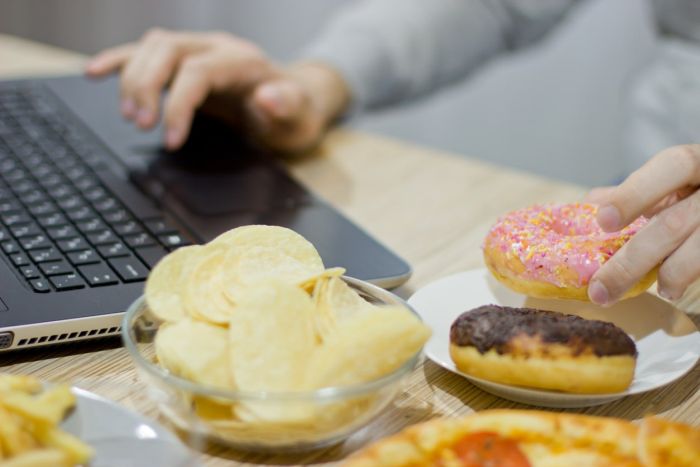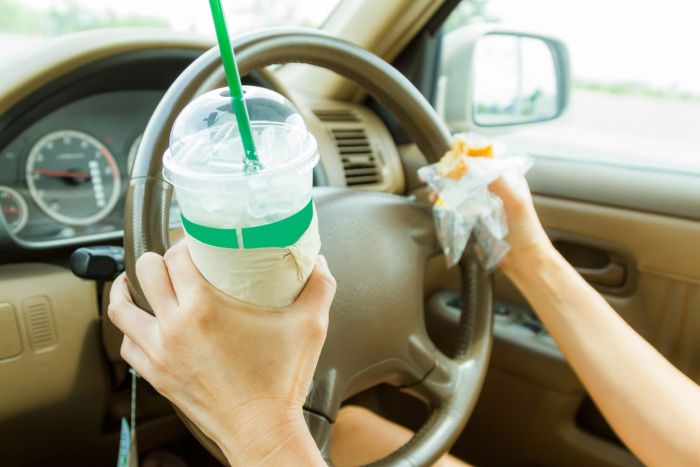Hungry, but no time to sit down for a quiet meal? Perhaps you’re upset and overwhelmed by a long list of deadlines? Or, on the contrary, you’re bored and don’t know what to do with yourself? Be careful, these are all great excuses to reach for a snack, without thinking about what you’re eating or whether or not it’s good for you.
Find out which snacks are healthy.

Table of contents
The beginnings of healthy eating
Healthy snacking - does it exist?
What types of snacks to choose?
Why can’t we only eat one crisp?
Fresh apples versus apple crisps
Bad eating habits
Eating in a hurry, while stressed or mindlessly, for example in front of the TV, has a strong negative impact on your health and figure. Fluctuations in blood glucose levels after eating a candy bar quickly lead to feelings of lethargy and weakness. If you don’t know how to stop eating sweets, crisps, crackers and other salty snacks, this article is for you. Follow our advice to get rid of harmful eating habits.
How to start eating healthy?
Everything starts from the first step, and in the case of wise, balanced and healthy nutrition - from breakfast. It should be healthy, rich in slow-releasing ingredients that will give you energy throughout the entire morning. Eat it in a relaxed setting, savouring every bite. When it comes to breakfast, don’t worry too much about counting calories, as you will burn most of them quickly as you go about your day. Pay attention to other meals as well. By eating regularly, five times a day, we reduce our desire to snack, says Magdalena Kalinowska, a specialist in preventive medicine.
Snacking between meals
Every day we snack on something between the three main meals. Of course, we try not to eat fast-food (after all, we have known for a while now how harmful it is!), but it doesn’t stop us from reaching for a chocolate biscuit or a handful of fatty crisps from a colleague's desk... Sometimes these snacks constitute a fourth full meal. After a month, these seemingly innocent snacks can add up to 4 boxes of biscuits, 7 bags of crisps and litres of sweetened and coloured beverages.
We often forget that fast-food is not just a chain of popular restaurants. It is also mindless snacking, forgetting about empty calories and rush. All this ruins our bodies, contributes to the storage of extra fat and negatively affects our well-being.
Calorie table
If you still find it difficult to refrain from eating something on the run or while lying on the couch, take a look at the following table:
Product | Number of calories |
fries (100 g) | 250 kcal |
crisps (100 g) | 550 kcal |
small candy bar | 445 kcal |
pastry with filling | approx. 320 kcal |
vanilla cappuccino | 300 kcal |
fudge toffees (100 g) | 418 kcal |
plum puff pastry | 442 kcal |
pretzels | 380 kcal |
can of sweetened soda | 130 kcal |
Crisps are very fatty and caloric, very salty, and often spicy, which makes you thirsty. They contribute to constipation and hypertension.
Donuts, pastries, candy bars and biscuits contain a lot of calories, and few valuable nutrients. Consuming them leads to obesity and overloads the stomach.
In turn, coloured carbonated beverages contain sodium benzoate, caffeine, some contain quinine, aspartame, carbon dioxide and phosphoric acid. These substances disturb iron absorption, flush out magnesium, act as stimulants, and overdosing on them can cause disorders of the digestive system.
Eating overly salty snacks rich in sugar, preservatives, artificial colours and flavour enhancers, disturbs the metabolic balance and leads to an impoverished diet. This in turn results in health problems and excessive weight.

The beginnings of healthy eating
Initially, any attempt to change existing habits seems very difficult. Although we are aware that certain products are harmful to us, it is hard for us to give them up completely and permanently, and it often turns out that we don’t have much of willpower after all. What then?
The easiest way to tackle this difficult challenge of changing bad habits is by taking small steps. So if we want to stop snacking on crisps, for example, we should set up a plan and follow a few rules:
- Begin with gathering as much information as possible on the ingredients contained in the snack we want to give up. We all want to be healthy, so we can’t ignore the fact that by consuming processed products we are filling our bodies with large doses of preservatives and flavour enhancers, which are stored and contribute to the occurrence of serious diseases. In the case of crisps and fries, the greatest threat is the substance that is formed during long-term frying of starch-containing products - acrylamide. The International Agency for Research on Cancer classifies it as Group 2A, or substances that are likely to cause cancer in people.
- Once we are aware of how many chemicals are contained in a seemingly innocent package of flavoured crisps - monosodium glutamate, aromas, salt, trans fats, etc. - we should get into the habit of reading the ingredients on the packaging each time we reach for this snack. After some time, we will begin to experience slight discomfort at the sight of all the possible varieties of E-ingredients, nature-identical ingredients and dyes.
- Although we will still probably be tempted to reach for crisps from time to time, we will eat them with awareness of how unhealthy they are. The carelessness with which we will reach for the next packet will also disappear.
- If we follow this plan, there will come a day when we will decide not to open that packet of crisps, aware that there are healthier, better-tasting snacks available.
Healthy snacking - does it even exist?
You already know that eating harmful snacks ruins your health and figure, and yet you still can’t stick to eating only three main meals per day? Reach for products that will not fill you with needless calories, but will help stop overeating and prevent sudden attacks of hunger. Healthy snacks really do exist! Their aim is to satisfy hunger, fill you up and maintain the metabolic rate. They also help keep your blood glucose levels steady. When the body gets used to this, it will stop storing fat deposits.
A wisely-chosen snack can be a part of a healthy diet. This includes fresh or dried fruit and vegetables, nuts, crisp bread and natural yoghurt, says Magdalena Kalinowska. Just make sure not to eat too much. For example, eat only a handful of healthy but caloric almonds and nuts, and consume dried fruits in moderation (we are able to eat much more of them than fresh ones, so we can unconsciously consume too many extra calories).
What types of snacks to choose?
If you know that you have a tendency to snack and it is difficult to fight the temptation, don’t go against your own nature, but try to change this harmful habit into a healthy and useful one.
When you get hungry, reach for seasonal vegetables and fruits. In winter and early spring, you can choose their frozen varieties, because such stored products do not lose their nutritional value and vitamins. Fruits and vegetables are a valuable source of vitamins and minerals, while the fibre contained in them regulates the functioning of the digestive tract, preventing constipation, and accelerates metabolism, helping us lose unnecessary kilograms. Because fruits have more sugar than vegetables, we should especially choose the latter for snacks, such as celery, iceberg lettuce, cucumbers and carrots (the beta-carotene in carrots supports cell regeneration and improves the skin, making it more smooth and firm).
A good choice is natural yoghurt or other snacks rich in filling protein. In order to digest a slice of lean white cheese or a glass of buttermilk, the body needs a lot of energy that it gets from fat tissue. When choosing yoghurt, choose one that contains only milk and bacterial strains (a long list of additives in the ingredients should discourage you). If you want something sweet, add your favourite fresh fruits, raisins or natural juices to natural yoghurt.
Other invaluable healthy snacks include nuts and seeds, such as pumpkin, sunflower and sesame seeds, which contain a lot of vitamin A, E and B, as well as iron, zinc, silicon (responsible for healthy skin and nails), and magnesium (supports concentration). They are also rich in mono- and polyunsaturated fatty acids, thanks to which they lower bad cholesterol, as well as the risk of coronary heart disease. At the same time, these products are quite caloric, which is why the daily portion of nuts should not exceed approx. 30 g.
Healthy snacks
When making changes to your diet, you should have some proven healthy snacks on hand:
- fresh vegetables, cut into strips or florets, served with a lemon Feta cheese dip or yoghurt dill dressing;
- hand-made cauliflower, spinach, aubergine or carrot crisps;
- oatmeal muffin cups that are easy to fill with any filling, e.g. Greek yoghurt, salmon or colourful peppers;
- toast made from wholegrain baguette, served in the form of bruschetta with tomatoes or with mackerel paste, sprinkled with sprouts;
- pumpernickel appetizers with pear, cherry tomatoes, olives, low-fat deli meat and blue cheese;
- wholegrain biscuits and rolls sweetened with fruit juice;
- homemade muesli with grains;
- hollowed baked apple, served with a teaspoon of currant jam and topped with natural yoghurt.
The possibilities are endless, you just have to use your culinary imagination. It pays to motivate yourself to follow these habits, keeping in mind that healthy snacks are much more beneficial than low nutritional value products, and when eaten in the right quantities have no disadvantages.
Why can’t we only eat one crisp?
The combination of salt, sugar (contained in potato starch) and fat (oil) has a very strong effect on the hunger centre in the brain. Salt drives our appetite because it strongly affects the sensitive taste buds. Sugar also stimulates appetite, while causing fluctuations in blood glucose levels. We also like fat, which makes food taste better, and we have already gotten used to this distinctive taste, despite the fact that it has led to the epidemic of obesity and type 2 diabetes.
Fresh apples versus apple crisps
Both are healthy, but there is one basic difference between them. 100 g of apples contain approx. 60 kcal, while 100 g of dried apples have as much as 243 kcal. Remember that during the drying process, due to the evaporation of water, the weight of the product changes dramatically, but not the amount of sugar contained in it.
When choosing other dried fruits, such as apricots, dates, raisins or unsweetened pineapples, we should make sure they don’t contain sulphur.
